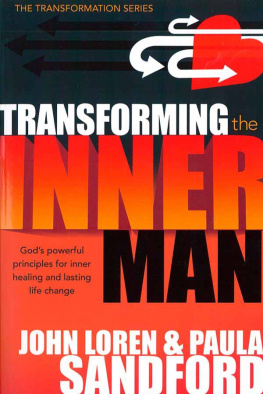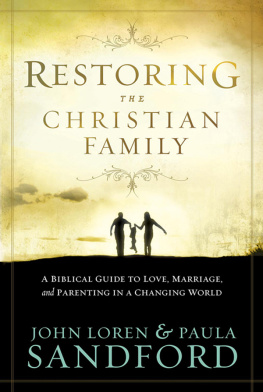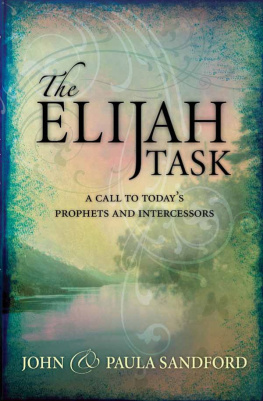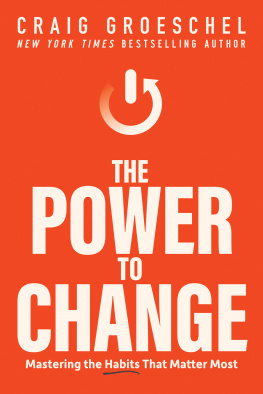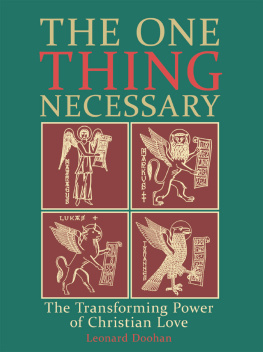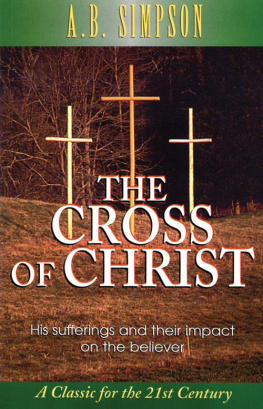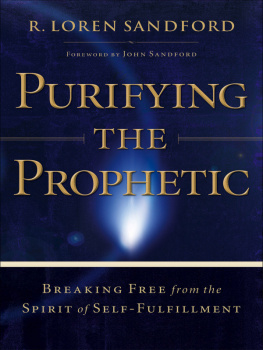
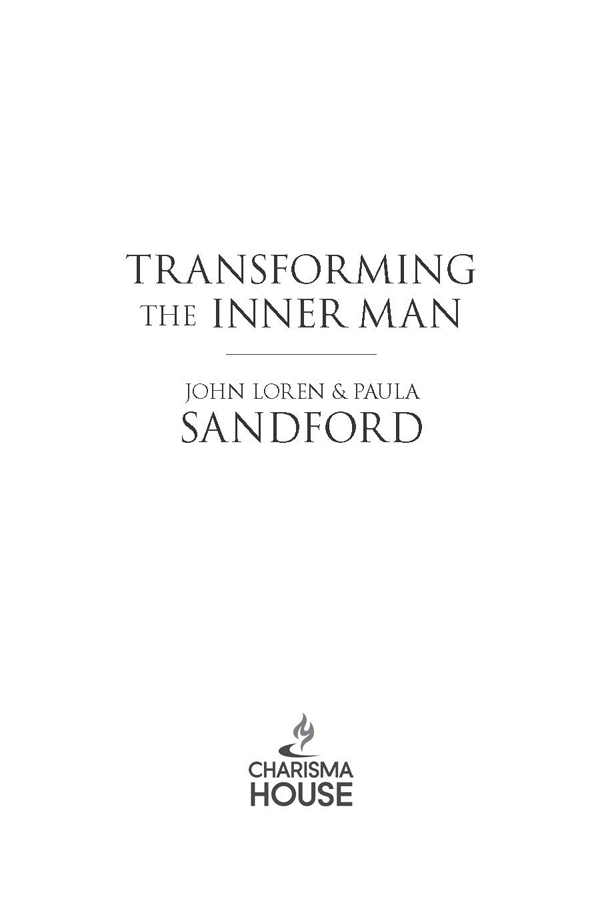
Most CHARISMA HOUSE BOOK GROUP products are available at special quantity discounts for bulk purchase for sales promotions, premiums, fund-raising, and educational needs. For details, write Charisma House Book Group, 600 Rinehart Road, Lake Mary, Florida 32746, or telephone (407) 333-0600.
TRANSFORMING THE INNER MAN by John Loren and Paula Sandford
Published by Charisma House
Charisma Media/Charisma House Book Group
600 Rinehart Road
Lake Mary, Florida 32746
www.charismahouse.com
This book or parts thereof may not be reproduced in any form, stored in a retrieval system, or transmitted in any form by any meanselectronic, mechanical, photocopy, recording, or otherwisewithout prior written permission of the publisher, except as provided by United States of America copyright law.
Unless otherwise noted, all Scripture quotations are from the New American Standard Bible. Copyright 1960, 1962, 1963, 1968, 1971, 1972, 1973, 1975, 1977 by the Lockman Foundation. Used by permission. (www.Lockman.org)
Scripture quotations marked AMP are from the Amplified Bible. Old Testament copyright 1965, 1987 by the Zondervan Corporation. The Amplified New Testament copyright 1954, 1958, 1987 by the Lockman Foundation. Used by permission.
Scripture quotations marked KJV are from the King James Version of the Bible.
Scripture quotations marked NIV are from the Holy Bible, New International Version. Copyright 1973, 1978, 1984, International Bible Society. Used by permission.
Scripture quotations marked NKJV are from the New King James Version of the Bible. Copyright 1979, 1980, 1982 by Thomas Nelson, Inc., publishers. Used by permission.
Scripture quotations marked RSV are from the Revised Standard Version of the Bible. Copyright 1946, 1952, 1971 by the Division of Christian Education of the National Council of the Churches of Christ in the USA. Used by permission.
Cover design by Rafael Sabino
Design Director: Justin Evans
Copyright 2007 by John Loren and Paula Sandford
All rights reserved
Library of Congress Cataloging-in-Publication Data
Sandford, John Loren.
Transforming the inner man / by John and Paula Sandford.
p. cm.
Includes bibliographical references.
ISBN 978-1-59979-067-1 (trade paper)
1. Spiritual healing. 2. Sanctification--Christianity. 3. Pastoral counseling. I. Sandford, Paula. II. Title.
BT732.5.S23 2007
248.4--dc22
2006033635
E-book ISBN: 978-1-59979-621-5
Portions of this book were previously published as TheTransformation of the Inner Man by John and Paula Sandford, copyright 1982 by Victory House, Inc., ISBN 0-932081-13-4; and as Healing the Wounded Spirit by John and Paula Sandford, copyright 1985 by Victory House, Inc., ISBN 0-932081-14-2.
This publication is translated in Spanish under the title Cmo transformar el hombre interior, copyright 2007 by John Loren and Paula Sandford, published by Casa Creacin, a Charisma Media company. All rights reserved.
CONTENTS
IN 1906 AT AZUSA STREET, the long-prophesied fall of the Holy Spirit in the latter days began. (See Joel 2:2829.) Since then, the miracle of the Holy Spirits presence has continuously expanded. The Lord is now giving back to the Church the gifts of Ephesians 4:11apostles, prophets, evangelists, pastors, and teachers. Men and women are being raised up to serve in high places: A mans gift makes room for him (Prov. 18:16). Wondrous giftings are elevating many into prominence. All of that is good and to be celebrated. But too many rising leaders are fallingsome to immorality, others to pressures in their families and organizations, and so on. Demonic attacks are increasing.
A great problem is that many leaders are like knights with great gaping holes in their armor, and Satan knows how to bring just the right (or wrong) persons and circumstances to bring them down. Many have not had their eleven years in Tarsus as Paul did. In Tarsus God turned a Pharisees heart into the great loving saint who wrote most of the letters in the New Testament. What has been missing from the Church during this present great outpouring of Gods Spirit is a proper theology and understanding of how believers hearts are to be sanctified after being born anew. Throughout Church history, disciplines and practices for sanctification and transformation have been developed. Believers knew their conversion did not end the process of change; it began it. But that wisdom has largely been lost to this generation.
What happened was that in America, when the westering movement began, people began to pour across the Alleghenies, seeking land and a better life. Thus, for the first time in modern history, the Church was confronted with a moving populace. People had mostly been stationary, living near their birthplace and attending the same church all their lives. Except for a few Congregationalists and Anabaptists, all were members of state churches, supported by taxes. In America, volunteerism arosechurches had to be supported voluntarily by gifts. Electivism was birthed; for the first time, each one chose (elected) where he would go to church. Space broke down ecclesiastical control. By the time an answer to a problem came back from the mother country, by necessity the situation had long had to be settled. Old ways of doing church would no longer work. Thus, leaders had to devise ways of ministering to a fast-moving populace. One of the most cogent answers became a reduction of the Gospel to its simplest messagefrighten sinners into the hands of an angry God and then drive them into the arms of a loving Savior, Jesus. Sawdust and tears revivalism was born on the American frontier; evangelistic revival preaching had never existed before. It did bear some good fruit. In the first and second Great Awakenings in America, nearly 60 percent of the populace were converted, and many more heard the claims of the Gospel.
But that reduced Gospel knew nothing of sanctification and transformation after being born anew! Many who heard were called to preachand therefore also knew nothing of ministry to the hurting hearts of the already believing. John and Charles Wesley knew in part and developed a method of sanctification after conversion, for which the church they founded is called to this day the Methodist church. But in the fast-flowing evangelism of the frontier, even that was lost.
Eventually preachers began to claim more for the born-anew experience than Scripture can justify. Thats not hard to do, because our salvation experience accomplishes so much: our direction is changed from hell to heaven, our sins are forgiven and guilt is washed away in the blood, our flesh is dealt a deathblow, we are restored to fellowship with the Father and with each other, we are given a new heart, and we are filled with the Holy Spirit. But our conversion does not end the process of being transformed into the loving character of Jesus; it begins it. Revival preachers, however, began to claim that from the moment we receive our Lord, our entire character is changed, and we become totally new creatures. Positionally that is true. But Paul, who above all the other apostles made it clear that we are saved solely by grace, also stated clearly that we must work out [our] salvation with fear and trembling (Phil. 2:12), that we receive our salvation (healed and transformed character) as the outcome of [our] faith (1 Pet. 1:9), not the beginning. But to the many Christians who only knew a concept of conversion that said they were changed more than in actual fact had yet happened, that biblical fact was lost.
Next page
